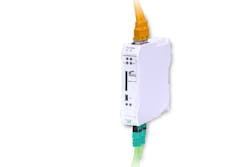Device interoperability has been the objective of industrial end users for decades. Pressure to achieve this goal has only become more intense with the advent of the Internet of Things, Industry 4.0 and increasingly connected intra- and inter-company supply chains.
To address this connectivity challenge, Hilscher, a supplier of industrial fieldbus and Ethernet communications technology, has announced the upcoming release of its NT 151 coupler. The NT 151 was developed in response to the joint specification released by the CC-Link Partner Association (CLPA) and Profibus & Profinet International (PI) to allow for easy interoperability between CC-Link IE and Profinet.
According to Hilscher, the NT 151 coupler is the first such product to be released in accordance with the joint specification that enables “both networks to seamlessly share information” with each other. In its release announcing the new product, Hilscher states: “With the new coupler, users can effectively achieve communication between differing parts of a line on separate networks, hugely increasing transparency and integration. The simple bridge between the two networks will dramatically reduce the engineering work that has traditionally been necessary to achieve integration across the heterogeneous network architectures that are a fact of life in numerous plants around the world.”
Armin Pühringer, Hilscher’s business development manager, explained that the PI/CLPA joint specification covers cyclic and acyclic/transient communication. In response, the NT 151 was designed to “work as a slave on both sides towards the Profinet and CC-Link IE networks. Its key functionality is to allow both network masters to interoperate with each other.”
The fundamental mechanisms of the NT 151 coupler include:
- A mapping model to map data from both sides;
- Diagnostics for coupler and networks; and
- The SyCon-based DTM which works as the coupler configuration tool.
Based on Hilscher’s experience with its netTAP protocol converters, Pühringer noted two aspects of equipment interoperability that are most relevant in the context of Industry 4.0. “The first aspect is to connect complete networks,” he said. “TheNT 151coupler enables this interoperability between CC-Link IE and Profinet.” He added that the new coupler’s connection capabilities provide end users with an additional method of achieving interoperability in brownfield applications versus the use of communication architectures that require existing devices to support additional technologies or protocols.
The second aspect of Industry 4.0 equipment interoperability highlighted by Pühringer is the ability to introduce connectivity to devices having only one protocol capability—in this case, either CC-Link IE or Profinet. The ability to provide this level of connectivity to such devices “requires a link device that functions as a slave on one side and a master on the other side.” Providing this capability is the next step in full connectivity between CC-Link IE and Profinet devices that Hilscher will be focusing on pursuant to Industry 4.0 requirements. This forthcoming link device will be based on the NT 151 coupler.
The official launch of the NT 151 will take place this November, with the full product release expected by mid 2018.


